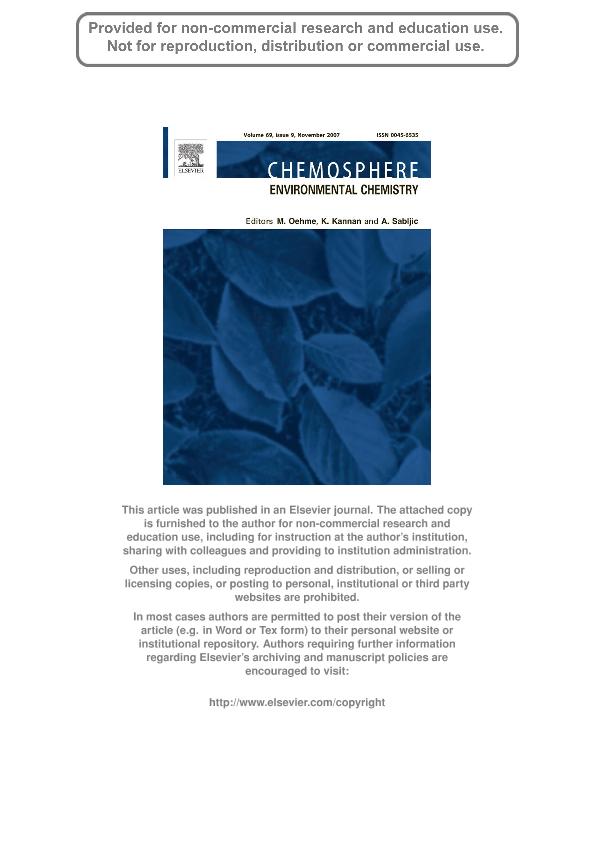Mostrar el registro sencillo del ítem
dc.contributor.author
Minaberry, Yanina Susana

dc.contributor.author
Gordillo, Gabriel Jorge

dc.date.available
2020-04-21T15:41:59Z
dc.date.issued
2007-11
dc.identifier.citation
Minaberry, Yanina Susana; Gordillo, Gabriel Jorge; Complexing capacity of natural waters carrying a great amount of suspended matter; Pergamon-Elsevier Science Ltd; Chemosphere; 69; 9; 11-2007; 1465-1473
dc.identifier.issn
0045-6535
dc.identifier.uri
http://hdl.handle.net/11336/103137
dc.description.abstract
The cadmium binding properties of waters of the superior section of the Rio de la Plata estuarine were determined over a three-year period. Samples were collected at different hydrodynamic conditions. The complexing capacity was determined by square wave anodic stripping voltammetry (SWASV). Titration curve data were analyzed using a multivariable regression. Suspended particulate matter (SPM) was identified by XR diffraction and FTIR. These analyses showed that SPM principal components are clays (illite, montmorillonite and chlorite). The study was applied to the untreated, filtered and centrifuged fractions of each sample at the pH of the natural waters and at pH 1. The results show that the contribution of dissolved organic matter to the complexing capacity is negligible when compared with SPM. At natural pH, the complexing capacity of filtered and untreated fractions can be described by considering two kinds of binding sites. The associated conditional binding constants are independent of the concentration of suspended matter. Their average logarithms are ca. 6.5 and ca. 4.4. The total concentration of binding sites (ST) is in μM range, which is about three orders of magnitude higher than that reported for most of the studied estuaries. This difference is explained on the basis of the great amount of SPM. Hydrodynamic conditions produce variations in the concentration and composition of the SPM. At pH 1 samples still exhibit an important complexing capacity with only one binding site with log Kcond ca. 5.4. These differences could be attributed to superficial modifications that take place at very low pH.
dc.format
application/pdf
dc.language.iso
eng
dc.publisher
Pergamon-Elsevier Science Ltd

dc.rights
info:eu-repo/semantics/openAccess
dc.rights.uri
https://creativecommons.org/licenses/by-nc-sa/2.5/ar/
dc.subject
COMPLEXING CAPACITY
dc.subject
SQUARE WAVE ANODIC STRIPPING VOLTAMMETRY
dc.subject
SUSPENDED PARTICULATE MATTER
dc.subject
CADMIUM
dc.subject.classification
Físico-Química, Ciencia de los Polímeros, Electroquímica

dc.subject.classification
Ciencias Químicas

dc.subject.classification
CIENCIAS NATURALES Y EXACTAS

dc.title
Complexing capacity of natural waters carrying a great amount of suspended matter
dc.type
info:eu-repo/semantics/article
dc.type
info:ar-repo/semantics/artículo
dc.type
info:eu-repo/semantics/publishedVersion
dc.date.updated
2020-04-17T14:39:40Z
dc.journal.volume
69
dc.journal.number
9
dc.journal.pagination
1465-1473
dc.journal.pais
Estados Unidos

dc.description.fil
Fil: Minaberry, Yanina Susana. Universidad de Buenos Aires. Facultad de Ciencias Exactas y Naturales. Departamento de Química Inorgánica, Analítica y Química Física; Argentina. Consejo Nacional de Investigaciones Científicas y Técnicas. Oficina de Coordinación Administrativa Ciudad Universitaria. Instituto de Química, Física de los Materiales, Medioambiente y Energía. Universidad de Buenos Aires. Facultad de Ciencias Exactas y Naturales. Instituto de Química, Física de los Materiales, Medioambiente y Energía; Argentina
dc.description.fil
Fil: Gordillo, Gabriel Jorge. Consejo Nacional de Investigaciones Científicas y Técnicas. Oficina de Coordinación Administrativa Ciudad Universitaria. Instituto de Química, Física de los Materiales, Medioambiente y Energía. Universidad de Buenos Aires. Facultad de Ciencias Exactas y Naturales. Instituto de Química, Física de los Materiales, Medioambiente y Energía; Argentina. Universidad de Buenos Aires. Facultad de Ciencias Exactas y Naturales. Departamento de Química Inorgánica, Analítica y Química Física; Argentina
dc.journal.title
Chemosphere

dc.relation.alternativeid
info:eu-repo/semantics/altIdentifier/doi/https://doi.org/10.1016/j.chemosphere.2007.04.058
dc.relation.alternativeid
info:eu-repo/semantics/altIdentifier/url/https://www.sciencedirect.com/science/article/pii/S0045653507005851
Archivos asociados
